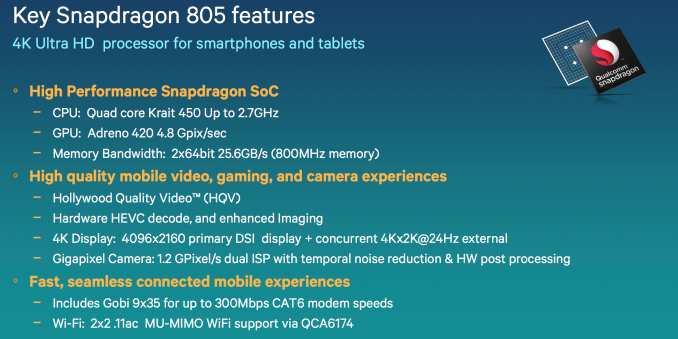Qualcomm Snapdragon 805 Performance Preview
by Anand Lal Shimpi on May 21, 2014 8:00 PM EST- Posted in
- Tablets
- Snapdragon
- Qualcomm
- Mobile
- SoCs
- Snapdragon 805
Final Words
Qualcomm tends to stagger the introduction of new CPU and GPU IP. Snapdragon 805 ultimately serves as Qualcomm's introduction vehicle for its Adreno 420 GPU. The performance gains there over Adreno 330/Snapdragon 801 can be substantial, particularly at high resolutions and/or higher quality settings. Excluding 3DMark, we saw a 20 - 50% increase in GPU performance compared to Snapdragon 801. Adreno 420 is a must have if you want to drive a higher resolution display at the same performance as an Adreno 330/1080p display combination. With OEMs contemplating moving to higher-than-1080p resolution screens in the near term, leveraging Snapdragon 805 may make sense there.
The gains on the CPU side are far more subtle. At best we noted a 6% increase in performance compared to a 2.5GHz Snapdragon 801, but depending on thermal/chassis limitations of shipping devices you may see even less of a difference.
Qualcomm tells us that some of its customers will choose to stay on Snapdragon 801 until the 810 arrives next year, while some will choose to release products based on 805 in the interim. Based on our results here, if an OEM is looking to specifically target the gaming market I can see Snapdragon 805 making a lot of sense. For most of those OEMs that just launched Snapdragon 801 based designs however, I don't know that there's a huge reason to release a refresh in the interim.
I am curious to evaluate the impact of ISP changes as well as dive deeper into 4K capture and H.265 decode, but that will have to wait until we see shipping designs. The other big question is just how power efficient Adreno 420 is compared to Adreno 330. Qualcomm's internal numbers are promising, citing a 20% reduction in power consumption at effectively the same performance in GFXBench's T-Rex HD onscreen test.












149 Comments
View All Comments
bradleyg5 - Thursday, May 22, 2014 - link
http://imgur.com/a/fkUhfCharts!
phoenix_rizzen - Friday, May 30, 2014 - link
Broken links!hardeswm - Thursday, May 22, 2014 - link
Anand,Would you consider including at least 1 Intel/AMD 'cost-effective' cpu, integrated graphics, and 'cost-effective' discrete gpu in these charts? A price per chip comparison would be very cool as well.
I am really interested in watching the performance gap close over the next year.
Thanks!
texasti89 - Thursday, May 22, 2014 - link
Nice GPU features & moderate performance bump. Not impressive, though. This release shows how bad we need to migrate to the next 20nm process node. Industry has done all they can to squeeze the heck out of current 28nm node. It's really frustrating to observe this stagnation of process technology.
rocketbuddha - Thursday, May 22, 2014 - link
IMHO, I do not think 805 will get much in the area of phones. Manufacturing wise it is more expensive. It needs to have a separate Gobi MDM to provide LTE connectivity. Instead the cheaper integrated 800/801 which are MSMs will continue to be used.IT could very well be a repeat of Q3-12-Q2-13 where in when the first QC Kraits appeared sans the integrated baseband.
That was a brief window of time that Note 2 as well as HTC One X+ sported Exynos and Tegra 3+ variants as the SOC and plus a Gobi MDM for LTE connectivity. So maybe Note 4 would have the next Exynos version with the Gobi MDM for the US version of the handset.
Tanclearas - Thursday, May 22, 2014 - link
Is that really correct that Snapdragon 808/810 will revert back to 2 x 32b memory interface? That doesn't seem right.frostyfiredude - Thursday, May 22, 2014 - link
810 is 2x32b LPDDR4 1600. 25.6GB/s, same as 805808 is 2x32b LPDDR3 933. 14.9GB/s, less than the others but still quite a lot of BW considering the GPU is smaller too.
Tanclearas - Friday, May 23, 2014 - link
The combination of a new 64-bit core and higher clocked GPU (note that the 810 shows Adreno 430) will put additional strain on the memory bandwidth. I think I'd rather see 4x32b LPDDR3 933.frostyfiredude - Friday, May 23, 2014 - link
Considering the hugely more powerful APUs from AMD and Intel are happy with 25.6GB/s using architectures which are less bandwidth conscientious; I'm sure these Snapdragons will be limited by thermals far before memory.vortmax2 - Thursday, May 22, 2014 - link
Bring on the Note 4 with this!